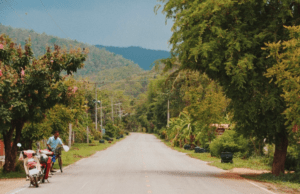Note: written on May 24
Meal times are my favorite times at Ono Farm, not just because of the delicious organic food and by no means because the other activities are unenjoyable. At the dining table, we have had conversations about anything under the sun, and as the days pass our conversations have become deeper, more honest and more personal.
A typical meal at Ono Farm looks like this: when Masako-san is done cooking, Jing Ying and I would hustle into the kitchen to help set up the dining table. Yuji-san would return from the farm all sweaty and tired and take a quick shower while the three of us take our specific seats. Upon joining us, though, Yuji never brings his fatigue to the dining table and never lets anyone worry about him, instead fully recovering his amicable smile and outgoing demeanor. We next excitedly chant “Itadakimasu” together, upon which we are allowed to dig in to the delicious food Masako has made with fresh organic produce from their own farm. We would first share about what each of us have accomplished, and then move on to discussing anything that any of us spontaneously brings up. Our conversations develop organically (literally too) but are in no way superficial — all four of us happen to share a similar passion for a few issues and wider interest in many other topics, and more importantly, we share the same desire to learn and same open-mindedness to unfamiliar grounds.
At the dining table, I’ve discovered many things about Japan that I have been completely ignorant of and/or have not expected. Particularly on its food safety. Many of us in Singapore have this image of Japan as a country with quality produce due to their superb agricultural technique and perfect climate. We tend to attach their quality in taste and looks to their nutrition value as well, hailing them as health foods and elevating them to the same level as their organic counterparts. Unfortunately, this cannot be further from the truth. Ono Farm is one of the rare few organic farms in the Awa province. Even in the Tokushima prefecture and in Japan at large, organic farming has barely caught on as well. Most veggie farms still depend heavily (in fact increasingly so) on pesticides, herbicides, artificial growth stimulants, chemical fertilizers amongst others, with multiple causes behind this. For one, the government-initiated Japan Agricultural Cooperatives group (JA) are blatant opponents of organic farming. Not only do they promote (or rather, compel) the intensive use of highly subsidized chemical inputs, they are extremely unwelcoming towards organic farmers who try to join the cooperative and work with other farms. This has been a huge deterrent for farmers considering to switch from conventional to organic farming. Because of the Japanese government’s agricultural agenda coupled with its general lack of transparency, many Japanese remain ignorant about the deleterious impacts of such chemical-intensive farming on both environmental and human health. Neighbors of Ono Farm, for instance, would kindly offer to spray herbicides on Ono Farm when they see it infested with weeds, and are baffled when Yuji and Masako reject the offer. What compounds this problem is Japan’s culture of respect, reticence and deference, where one is inculcated from a young age the primacy of preserving the integrity of existing systems over airing one’s opinions. Yuji and Masako find it hard to explain their commitment to organic farming for fear of offending the conventional farmers around, just as the masses fail to question the government’s agriculture policies and concealing of information for fear of disrespecting the authorities and disrupting status quo. So yes, the perfect-looking Japanese rice, Kyoho grape and Wagyu beef that we covet are probably laden with chemicals.
Our conversations about Japan’s food security have also enlightened me in surprising ways. I came to Japan with the perception that Japanese take great pride in their local produce and depend little on foreign imports for food sustenance. Again, I am proven wrong. Japan cannot live without soybeans — its staples like natto, soy sauce and tofu are all made from that. Yet, three-quarters of its soybeans consumed are currently imported. While Japanese soybeans are all non-GMO, much of the imported ones are, but Japanese remain largely clueless about that fact. Soybeans are actually really difficult to grow, not to mention organic ones. The Japanese diet has also evolved from plant-based meals made from locally sourced ingredients to meat- and dairy-heavy meals thanks to Western influence, hence putting significant pressure on Japan’s soil to support animal agriculture, particularly highly polluting dairy farms. Such phenomena have compromised Japan’s ability to meet its own food preferences and dietary needs, making it more vulnerable to international fluctuations in food supply and climate change.
With a cup of home-brewed Umeshyu each (except Yuji who’s allergic to alcohol) loosening our tongues every dinner, beyond those two pet topics, we’ve talked about our travel experiences, our family, our schooling experiences, youth apathy and even our biggest regret in life. I’ve learnt about the the unimaginable hardships that Yuji and Masako have gone through as organic farmers in Japan swimming against the tide, receiving little to no support from family members, the community and the government. These conversations remind me how knowledgeable, wise, resilient and kind the pair are, and I will continue to hold them dearly to my heart.
